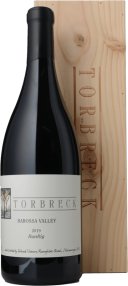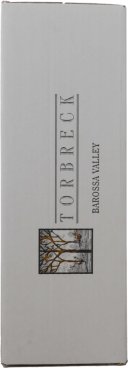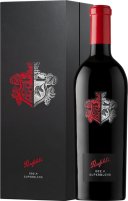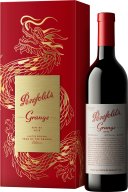Torbreck RunRig Shiraz
The flagship of the Torbreck stable. Recently been elevated to 'Exceptional' status in Langton's Fine Wine Classification, it is a wine of utmost power and density. Famous for rich concentration and opulent power, this exceptional Australian Shiraz is as popular abroad as it is at home. Definitely one to place in the cellar and simply forget about - let the patience reward you over 10 or more years time.
Château Cos D'Estournel St-Estèphe
In the upper echelon of 2nd Growth estates, Chateau Cos D''Estournel is located in St-Estephe appelltion, on the fringe of Paulliac and notably just north of the famed Lafite vineyards. Tourists flock to the Medoc estate to see the unusual, Asian-inspired Chateau design, but the wines hold their own and rightfully are considered the finest within St-Estephe. Oak is set to around 80% new barrels while alcohol is a modest 14.5%; the blend in 2010 is 78% Cabernet Sauvignon with 19% Merlot and complimentary Cabernet Franc and Petit Verdot in tow. A wine for thirty or so years.
Clarendon Hills Astralis
Torbreck The Forebear
Maker: Torbreck is a winery on a mission to become one of the world's great wine brands. Since 1994, they have remained committed to creating exceptional Rhone-style red and white wines that reflect the very best vineyards in Australia's famous Barossa region. Provenance is everything to them, and they believe that the Barossa is the most exciting place to make wine in the world. With a European sense of tradition, Torbreck pays tribute to the vineyards with minimal intervention, creating wines of richness, structure and length that age gracefully. The multi-generational growers, whose descendants arrived here nearly two centuries ago, are the backbone of Torbreck's winemaking aspirations. They work in partnership with the people of the Barossa who grow their fruit, always aiming to get the very best out of their vineyard sites. At Torbreck, they constantly seek to understand the difference between all of these special places in the Barossa and how this combination of soil, climate and farming experience is reflected in unique grape flavours. They are simply custodians, enhancing the innate expressiveness of the wines and enabling them to reveal over time their individual origins and personality. Torbreck is actually named after the forest near Inverness, Scotland where the winery's founder, David Powell worked as a lumberjack after completing university studies. Vineyard: The growing season was defined by a continuously warm to hot summer with no effective rainfall, wind and hail at flowering, and followed with three major frosts - resulting in an earlier and much smaller harvest than average. These tough conditions produced smaller clusters of intensely dark berries with thick fleshy skins contrasted against brown mature stalks. Whilst yields were down, once these vineyards were fermenting in our cellar the concentration of colour, tannin and aroma of the 2019 vintage was revealed. Wine style/Cuvee: Chief Winemaker, Ian Hongell, explains "we chose the name 'The Forebear' to honour the pioneering spirit of the Springbetts and other pioneering families and their role in establishing the Barossa as of the great winegrowing regions of the world. This wine is our tribute to those who came before us." The vines are from an ancient Heritage clone originally brought from Europe as cuttings and planted before the discovery of Phylloxera. These ancestor vines (125+ years old) are embedded in soils of sand over deep loam and red clay. The Forebear is crafted from the original 12 rows of ancient Shiraz vines planted by the Springbett family (1849) which represent an irreplaceable link to the early history of the Barossa as a viticultural treasure from the first generation of European settlers. They are Torbreck’s oldest collection of vines from any single plot. The cooler evening breezes that flow through the southern end of the Barossa produce an elegant style of Shiraz that is regarded for its distinctive aromatic, lifted floral notes and red fruit flavours, across a medium weight line intertwined with subtle rounded tannins. The core of red berry fruit and texture derived from these very old and gnarly vines produce an unmistakable degree of finesse and complexity that was calling out to bottled as a single site expression, and a reflection of place. Torbreck chief winemaker Ian Hongell and viticulturist Nigel Blieschke, who have driven this project since 2014, were firm in their belief that this vineyard had a rightful place in Torbreck’s pursuit of single-site wines of significance and pedigree. Shiraz comes from the Hillside Vineyard, planted c.1850. It undergoes 24 months in new French oak barriques (Troncais). Deep crimson with brilliant hue. A wine of poise and nobility from some of the world’s oldest living Shiraz vines. A complex nose of mostly red berry fruits such as red currant, red cherry and cassis fill the bouquet, complimented by savoury notes of wild thyme, garrigue, graphite, and sandalwood. The palate carries a wonderful textural mouthfeel with enveloping soft, round tannins and cleansing acidity that balance the wines modern Barossa elegance with the power of the harvest from extremely low yielding vines. A wine that pays homage to its forebears and their vision for grape growing and dry farming from the 19th century. Enjoy from 2026 and cellar to 2050+. Tasting: Aroma - Complex, Redcurrant, Ironstone Predominately red berry fruits, then cassis and savoury garrigue, wild thyme and sandalwood. Palate - Blood plum, Mulberry, Sumac Typical Barossan feel, ample but fresh. Baking spice, awash with dark fruits, a lick of aniseed, and forest accents. Finish - Chewy, Exotic Spices, Peppercorns Superb finish, long and with plenty of chewy tannin and flavour to sink your teeth into.
Château Ducru-Beaucaillou Saint-Julien
Standing out from the crowd with its distinctive yellow/brown label, Château Ducru-Beaucaillou was the first second growth producer to break away from the crowd and start to attract higher prices and create the
Penfolds Super Blend 802A Cabernet Shiraz
One Superblend. Two Interpretations. Superblend 802.A and Superblend 802.B represent two unique interpretations of the iconic Australian blend of cabernet sauvignon and shiraz, sourced from unique parcels destined for Penfolds flagships.The Superblend 802.A components were aged separately in new American oak hogsheads for 22 months prior to being blended. The cabernet sauvignon makes its structural presence felt comprising 68% of the blend, while the 32% shiraz contribution adds generosity. Unashamedly bold, immediately Penfolds.
Penfolds Superblend 802.B
An ascent of dark summer pudding aromatics, underpinned by a dark berry fruit base. An excellent line across palate; fine and persistent.
Penfolds Grange Shiraz LNY
Grange is arguably Australia’s most celebrated wine. Crafted with intensely structured shiraz grapes for an Australian style recognised as one of the world’s great wines. With an unbroken line of vintages from the experimental 1951, Grange demonstrates the synergy between shiraz and South Australia.
Maison Blue Grandeur Shiraz
2021 Maison Blue , Barossa Valley Shiraz Vintage Conditions The region received good early rains in autumn 2020 to replenish some moisture in the profiles, coming off some driest back to back seasons ever experienced. Winter rains were average and those vineyards that supplemented with irrigation to get moisture to depth set the vines up for spring growth and Spring rains were above average. Temperatures in November were above average without any significant weather events paving the way for a fantastic fruit set. January 24th was the only day Barossa Valley experienced temperature above 40ºC, not surprisingly, the subsequent mild conditions meant bunch and berry size remained average, achieving a great balance between quality and quantity. A vintage that can be described as almost “perfect”, not only ideal sugar ripeness but also physiological ripeness for quality wine production. Vineyard Selection This fruit is sourced from a single vineyard located the heart of Marananga on the renowned western ridge of the Barossa Valley, where the soils are predominantly red-brown loams over red clay, amidst shattered ironstone and quartz. The Shiraz from this vineyard has made Penfolds Grange seven times. Winemaking Daily sampling and tasting of the Shiraz grapes ensured that they were picked at optimal flavour ripeness. The Grapes were hand harvested and were destemmed and crushed into a single 5 tonne open top fermenter where twice daily pump overs were conducted to ensure maximum extraction of colour, flavour and tannins from the grape skins. At the conclusion of fermentation, the wine was pressed to a combination of 100% new American oak hogshead barrels for 19 months. Tasting Evaluation Colour: Brilliant, dense, purple core with a crimson rim. Aroma: Intense aromas of plum, blueberry, blackcurrant, and juniper berry interwoven with wafts of coconut, vanilla bean, liquorice and mocha chocolate. Palate: Fruit flavours of black plum, black cherries and raspberry coat the surfaces of the mouth with density and length. Complex notes of graphite and lead pencil add further complexity. Fruit core is framed by spicy, savoury oak playing a support role. A wine that will only get better with age. Enjoy now over the next 25 years.
Penfolds Grange Shiraz 750MLx3
Immediately understood, immediately recognised. Grange is crafted utilising fully-ripe, intensely-flavoured and structured shiraz grapes. The result is a unique style that is recognised as one of the most consistent of the world’s great wines. The 2021 release is an aromatic quilt - grated dark chocolate, pan juices, soy and spice on the nose. Dark fruits, sleek tannins and chocolate oak is expansive across the palate. A wine that will comfortably cellar for three decades.



























